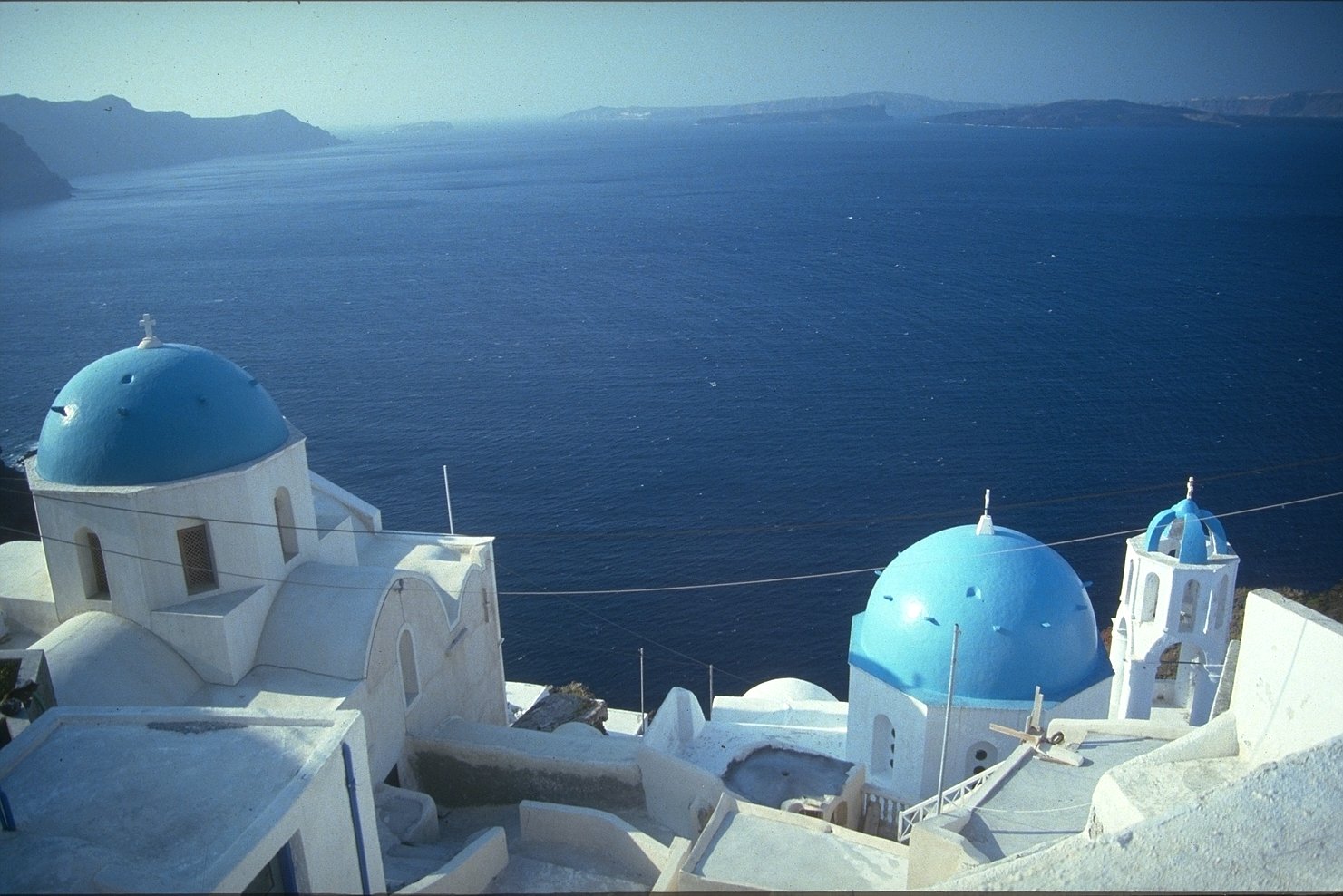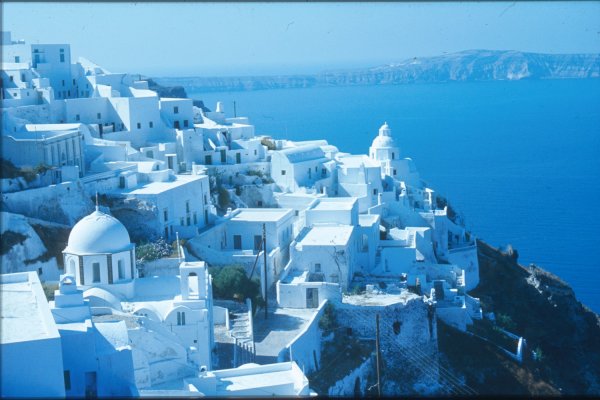| |
WELCOME TO SANTORINI!
The conference will take place at the NOMIKOS CONFERENCE CENTER on the island of Santorini in Greece. Santorini is one of the most appealing islands in Greece with beautiful beaches and landscapes, an interesting cultural heritage and excellent cuisine.
History of Santorini
 Santorini also known as Thira or Fira (which is the capital of the island),situated 900 feet above sea level and may be reached by port of Skala climbing the steep 566 broad steps where you can visit the folklore museum located in traditional cave home built in 1861 which includes a glimpse of the islands history. Sandorini is one of the most important prehistoric settlements of the Aegean. The large extent of the settlement, the elaborated drainage system, the sophisticated multistoried buildings with the magnificent wall paintings, furniture and vessels, show its great development and prosperity. Its various imported objects found in the buildings indicate the wide network of its external relations. After severe earthquakes followed a natural disaster, a volcanic eruption, which occurred some time at around 1450 BC, covering the entire island and the town itself, causing the middle of the volcano (Strongyli) to sink leaving a Caldera of high cliffs, these materials however have protected up to date the buildings and their contents. This was one of the world's most dramatic geographic spectacles. Just like in Pompeii.
Santorini also known as Thira or Fira (which is the capital of the island),situated 900 feet above sea level and may be reached by port of Skala climbing the steep 566 broad steps where you can visit the folklore museum located in traditional cave home built in 1861 which includes a glimpse of the islands history. Sandorini is one of the most important prehistoric settlements of the Aegean. The large extent of the settlement, the elaborated drainage system, the sophisticated multistoried buildings with the magnificent wall paintings, furniture and vessels, show its great development and prosperity. Its various imported objects found in the buildings indicate the wide network of its external relations. After severe earthquakes followed a natural disaster, a volcanic eruption, which occurred some time at around 1450 BC, covering the entire island and the town itself, causing the middle of the volcano (Strongyli) to sink leaving a Caldera of high cliffs, these materials however have protected up to date the buildings and their contents. This was one of the world's most dramatic geographic spectacles. Just like in Pompeii.
There is a theory, one that has fired the imagination of writers, artists and mystics since ancient times, which postulates that the island was part of the lost continent of Atlantis.
Akrotiri of Thira
 Four thousand years ago, there was a round island in the southern Aegean called Strongyli, which had been created piece by piece from solidified lava produced by the volcano. On Strongyli, at the town of Akrotiri, prospered one of the most significant prehistoric civilizations of the Mediterranean. Some time between 1625 and 1635 BC, the volcano erupted. This is known as the Minoan eruption causing a big part of Strongyli to sink and create a huge crater that filled with seawater and this is how what is now called the Caldera was formulated.
Four thousand years ago, there was a round island in the southern Aegean called Strongyli, which had been created piece by piece from solidified lava produced by the volcano. On Strongyli, at the town of Akrotiri, prospered one of the most significant prehistoric civilizations of the Mediterranean. Some time between 1625 and 1635 BC, the volcano erupted. This is known as the Minoan eruption causing a big part of Strongyli to sink and create a huge crater that filled with seawater and this is how what is now called the Caldera was formulated.
The civilization at Akrotiri has yielded the remains of the Minoan city destroyed around 1500 BC by the eruption of the volcano on Thira, destroyed the Bronze Age city of Akrotiri in the southest point of the island, burying under tons of volcanic ash the oldest examples of art in Europe. Discovered barley 30 years ago, the collection of the wall paintings of Akrotiri is one of the most important discoveries in art history. Many of the originals are still not accessible to the public.
In effect as mentioned above this is a pre historic version of Pompeii, also buried beneath volcanic ash we find, two and three-storeyed building, with squares, shops, workshops and so on…this leaving only three pieces of Strongyli: Sandorini, Thirassia and Aspronissi, much later the volcano gave birth to two more islands, Palia and Nea Kameni, which people now refer to as "the volcano". Palia Kameni was the result of series of eruptions from 46 BC to 726 AD, while Nea Kameni was "built" by six successive eruptions between 1570 and 1950.

WEBSITES OF INTEREST
|
|


 Santorini also known as Thira or Fira (which is the capital of the island),situated 900 feet above sea level and may be reached by port of Skala climbing the steep 566 broad steps where you can visit the folklore museum located in traditional cave home built in 1861 which includes a glimpse of the islands history. Sandorini is one of the most important prehistoric settlements of the Aegean. The large extent of the settlement, the elaborated drainage system, the sophisticated multistoried buildings with the magnificent wall paintings, furniture and vessels, show its great development and prosperity. Its various imported objects found in the buildings indicate the wide network of its external relations. After severe earthquakes followed a natural disaster, a volcanic eruption, which occurred some time at around 1450 BC, covering the entire island and the town itself, causing the middle of the volcano (Strongyli) to sink leaving a Caldera of high cliffs, these materials however have protected up to date the buildings and their contents. This was one of the world's most dramatic geographic spectacles. Just like in Pompeii.
Santorini also known as Thira or Fira (which is the capital of the island),situated 900 feet above sea level and may be reached by port of Skala climbing the steep 566 broad steps where you can visit the folklore museum located in traditional cave home built in 1861 which includes a glimpse of the islands history. Sandorini is one of the most important prehistoric settlements of the Aegean. The large extent of the settlement, the elaborated drainage system, the sophisticated multistoried buildings with the magnificent wall paintings, furniture and vessels, show its great development and prosperity. Its various imported objects found in the buildings indicate the wide network of its external relations. After severe earthquakes followed a natural disaster, a volcanic eruption, which occurred some time at around 1450 BC, covering the entire island and the town itself, causing the middle of the volcano (Strongyli) to sink leaving a Caldera of high cliffs, these materials however have protected up to date the buildings and their contents. This was one of the world's most dramatic geographic spectacles. Just like in Pompeii. Four thousand years ago, there was a round island in the southern Aegean called Strongyli, which had been created piece by piece from solidified lava produced by the volcano. On Strongyli, at the town of Akrotiri, prospered one of the most significant prehistoric civilizations of the Mediterranean. Some time between 1625 and 1635 BC, the volcano erupted. This is known as the Minoan eruption causing a big part of Strongyli to sink and create a huge crater that filled with seawater and this is how what is now called the Caldera was formulated.
Four thousand years ago, there was a round island in the southern Aegean called Strongyli, which had been created piece by piece from solidified lava produced by the volcano. On Strongyli, at the town of Akrotiri, prospered one of the most significant prehistoric civilizations of the Mediterranean. Some time between 1625 and 1635 BC, the volcano erupted. This is known as the Minoan eruption causing a big part of Strongyli to sink and create a huge crater that filled with seawater and this is how what is now called the Caldera was formulated.